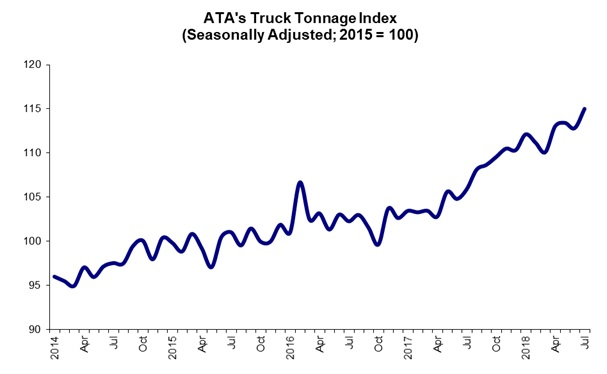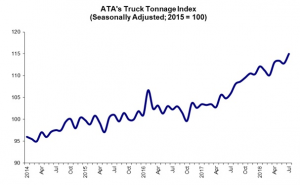American Trucking Associations’ (ATA) advanced seasonally adjusted (SA) For-Hire Truck Tonnage Index rose 1.9 percent in July after decreasing 0.5 percent in June. In July, the index equaled 115 (2015=100), up from 112.8 in June.
ATA, based in Arlington, Va., revised the June decline from the originally reported 0.4 percent to 0.5 percent.
Compared with July 2017, the SA index jumped 8.6 percent, up from June’s 7.7-percent year-over-year increase. Year-to-date, compared with the same period last year, tonnage increased 8 percent, far outpacing the annual gain of 3.8 percent in 2017.
The not seasonally adjusted index, which represents the change in tonnage actually hauled by the fleets before any seasonal adjustment, equaled 114.6 in July, which was 1.2 percent below the previous month (116.1).
ATA Chief Economist Bob Costello
Enjoying our insights?
Subscribe to our newsletter to keep up with the latest industry trends and developments.
Stay Informed“Truck freight remained very strong in July when accounting for normal seasonality,” said Bob Costello, ATA’s chief economist. “Both the month-to-month and year-over-year gains were the largest in three months. This robust growth stems from solid manufacturing, retail sales and construction activity. The industry’s biggest challenge isn’t finding enough freight, but recruiting and retaining quality drivers.”
Trucking the barometer of the Economy
Trucking serves as a barometer of the U.S. economy, representing 70.2 percent of tonnage carried by all modes of domestic freight transportation, including manufactured and retail goods.
Trucks hauled 10.77 billion tons of freight in 2017, according to ATA. Motor carriers collected $700.1 billion, or 79.3 percent of total revenue earned by all transport modes.
ATA calculates the tonnage index based on surveys from its membership and has been doing so since the 1970s. This is a preliminary figure and subject to change in the final report issued around the 10th day of the month. The report includes month-to-month and year-over-year results, relevant economic comparisons and key financial indicators.























